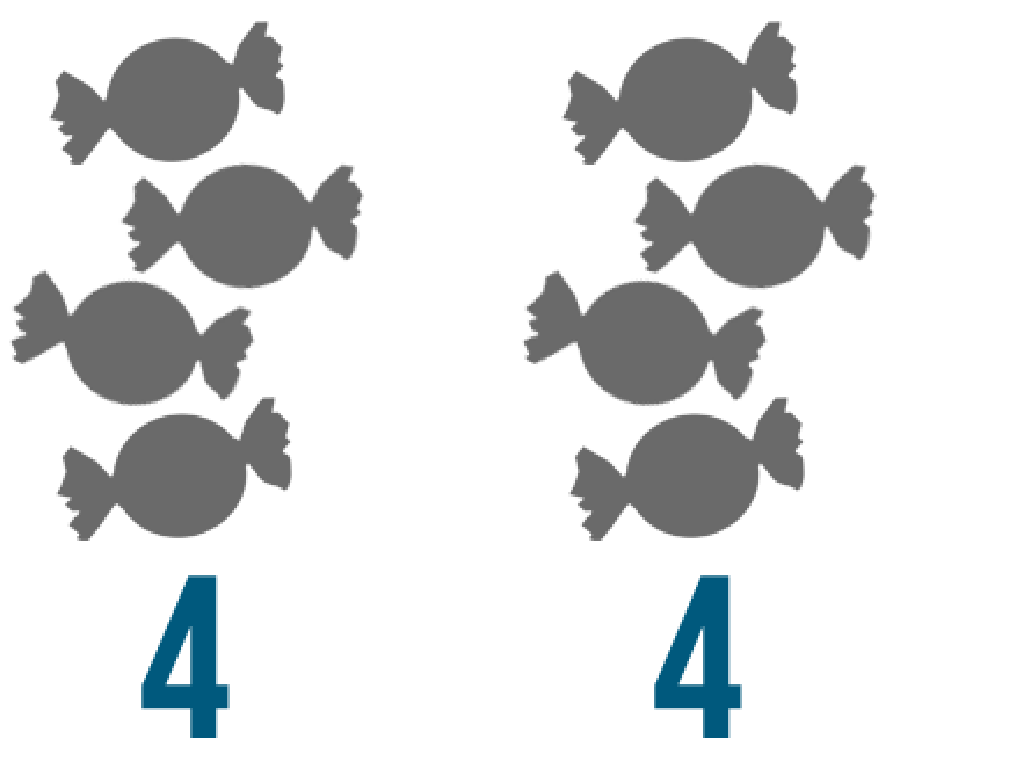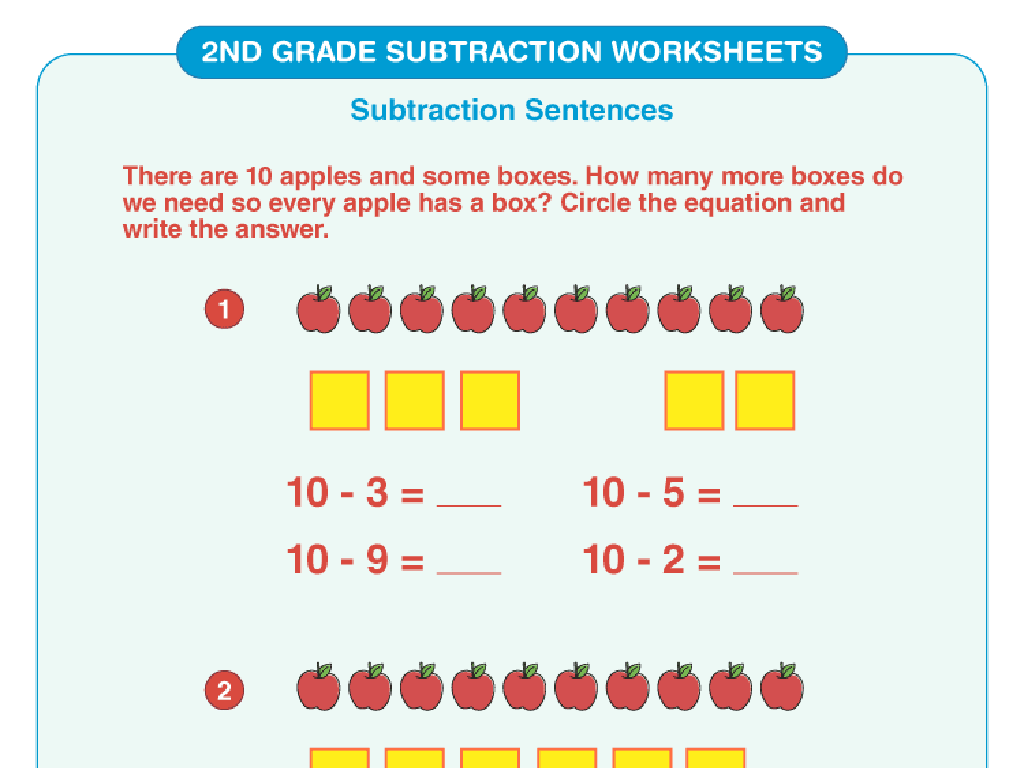Identify Equations
Subject: Math
Grade: Third grade
Topic: Equations With Unknown Numbers
Please LOG IN to download the presentation. Access is available to registered users only.
View More Content
Welcome to Equations!
– What is an equation?
– An equation is like a math sentence that shows two things are equal.
– Parts of an equation
– Equations have numbers, operations, and sometimes an unknown part we solve for.
– The ‘=’ sign meaning
– It tells us the amounts on both sides are the same.
– Finding the unknown
– We can play detective to find what number the unknown stands for!
|
Today’s lesson introduces the concept of equations to third graders. Start by explaining that an equation is a way to show that two things are equal using math. It’s like a balance scale where both sides need to weigh the same. Discuss the different parts of an equation, including numbers, plus and minus signs, and the unknown part, which is often represented by a letter like ‘x’ or a blank space. Emphasize that the ‘=’ sign is the key to understanding that the values on both sides of it are the same. Encourage students to think of finding the unknown as solving a mystery, where they use clues (the numbers and operations given) to figure out the missing piece. Provide simple examples and practice problems to help solidify their understanding.
Parts of an Equation
– Equations have two sides
– ‘=’ sign shows balance
– It’s like a seesaw that’s level
– Simple equation examples
– 4 + 3 = 7 shows both sides are the same
– Understanding ‘=’ in equations
– The ‘=’ tells us both sides have the same value
|
This slide introduces the basic concept of equations to third-grade students. Start by explaining that an equation is like a sentence in math that tells us two things are the same. The two sides of an equation are like two sides of a balance scale; they need to be equal, which is what the ‘=’ sign represents. Show simple equations like 4 + 3 = 7 to illustrate this point. Emphasize that the ‘=’ sign is very important because it tells us that the amount on one side is exactly the same as the amount on the other side. Encourage students to think of the ‘=’ sign as a symbol of balance and equality. Use real-life examples such as sharing cookies equally to make the concept relatable.
Mystery Numbers in Math
– Equations can have mysteries
– Symbols stand for unknown numbers
– Instead of ?, we might use a letter like ‘x’ or ‘n’
– Example: 4 + ? = 6
– What could we add to 4 to make 6?
– Solve the mystery to find the number
– We can play detective to find the missing number!
|
This slide introduces the concept of unknown numbers in equations to third-grade students. Start by explaining that sometimes in math, we come across a mystery where we don’t know one of the numbers in an equation. We can use a symbol or a letter to represent this unknown number. Provide an example such as 4 + ? = 6 and ask the students what number would make the equation true. Explain that finding this number is like solving a puzzle or being a detective. Encourage the students to think of the equation as a balance scale where both sides need to be equal. This will set the foundation for understanding algebraic thinking and problem-solving in future lessons.
Finding the Unknown in Equations
– Understanding the unknown number
– Solve with subtraction: 4 + ? = 6
– If 4 + ? = 6, what number makes this true? Use subtraction: 6 – 4 = ?
– Practice solving equations together
– We’ll try different problems like 5 + ? = 8
– Build confidence with examples
– Examples help us learn how to find the unknown
|
This slide introduces the concept of finding the unknown number in an equation, which is a fundamental skill in algebra. Start by explaining that the unknown number is like a mystery we can solve using math. Show how subtraction is used to find the unknown number in a simple addition equation. Engage the class with practice problems, solving them together to build confidence. Provide several examples and encourage students to explain their thinking process. This interactive approach helps students grasp the concept of unknowns in equations and prepares them for more complex algebraic thinking.
Creating Your Own Equations
– Create your own equation
– Use a symbol for the unknown
– Instead of a number, use ‘x’ or ‘?’
– Balance both sides of the equation
– Like a seesaw, both sides must be level
– Check your equation is correct
– Ask yourself, does my equation make sense?
|
This slide encourages students to apply their understanding of equations by creating their own. Remind them that an equation is like a sentence in math that shows that two things are equal, and it often contains an unknown number, which we can represent with a symbol like ‘x’ or a question mark. Emphasize the importance of balance in an equation, meaning that the value on one side of the equals sign should be the same as the other side. Encourage them to double-check their work to ensure their equation is correct. For the activity, students can write their equations on the board, and classmates can solve them, fostering a collaborative learning environment.
Class Activity: Equation Detectives
– Team up with a partner
– Solve the mystery number
– Use addition or subtraction to find the unknown
– Each team gets unique equations
– Present your findings to the class
– Explain how you solved the equations
|
This interactive class activity is designed to engage students in solving equations with unknown numbers. Students will work in pairs to foster collaboration and problem-solving skills. Each pair will receive a set of equations where they must identify the unknown number by applying their knowledge of addition or subtraction. After solving their set of equations, each team will have the opportunity to share their solutions and the strategies they used with the class. This will not only reinforce their understanding but also allow them to learn from each other. Possible activities include solving for a missing addend, finding the difference, or balancing two sides of an equation. Encourage creativity and praise logical thinking to build confidence.
Equation Detectives: Mission Accomplished!
– Congratulations, Equation Detectives!
– Mastery in identifying equations
– You can now find the unknowns in math problems
– Keep practicing solving equations
– Try more problems to become even better
– Practice leads to perfection
|
This slide is meant to congratulate the students on their hard work and understanding of identifying and solving equations with unknown numbers. Emphasize the importance of continued practice to enhance their skills. Encourage them to approach problems with confidence and remind them that making mistakes is a part of learning. Offer to provide additional worksheets and resources for them to practice at home. Celebrate their progress and encourage them to keep practicing, as this will help solidify their understanding and ability to solve equations.






